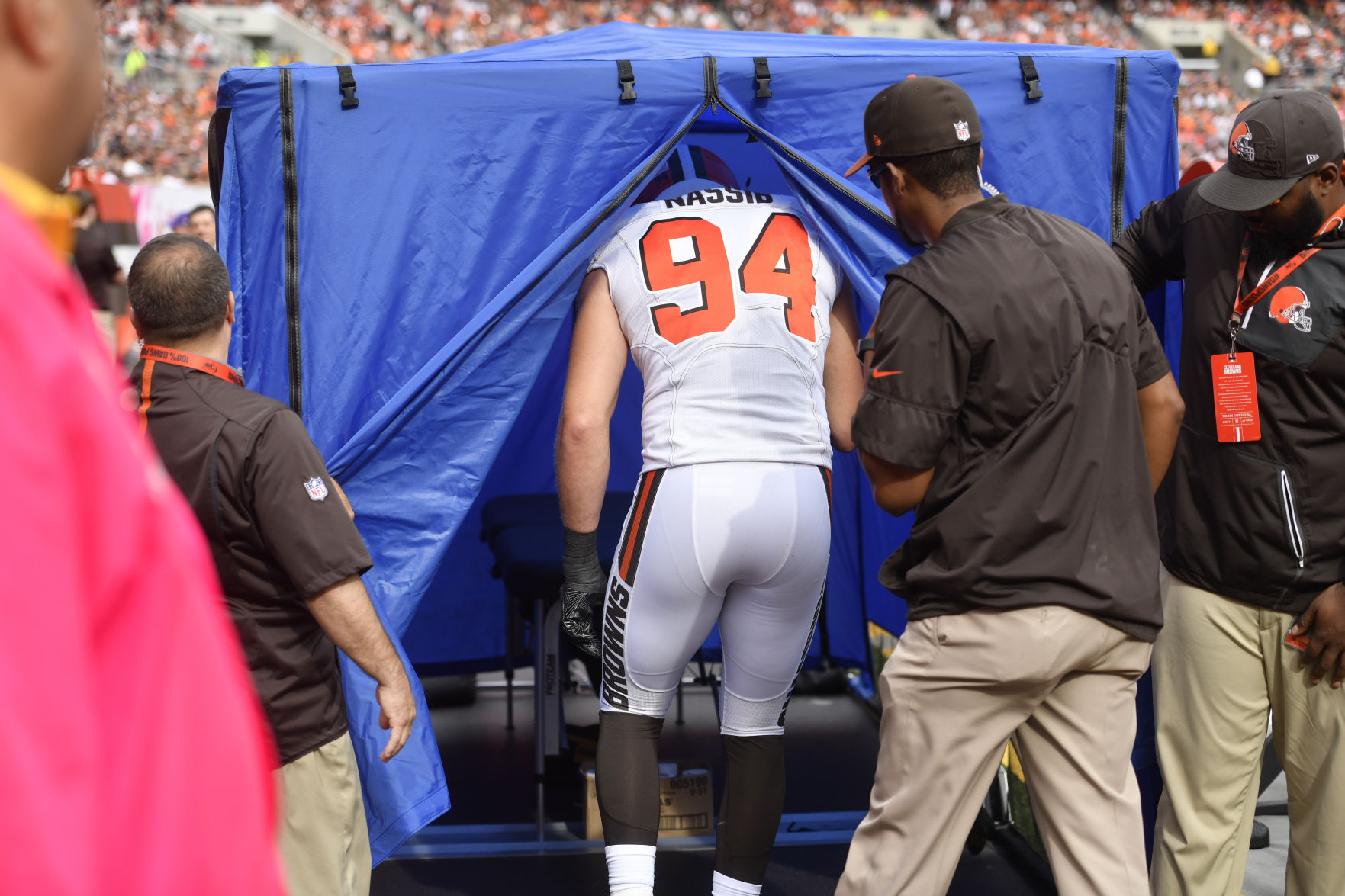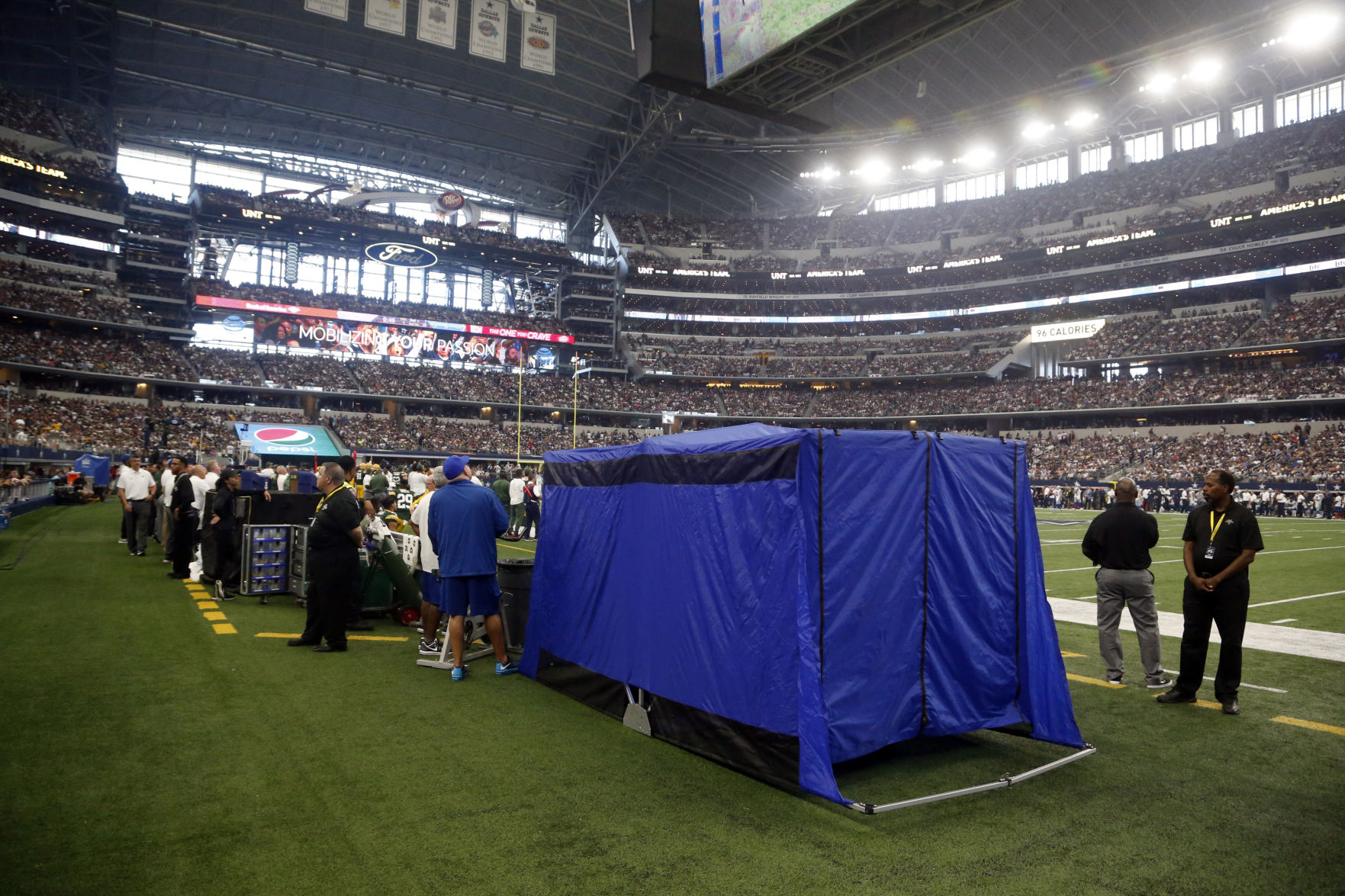NEW YORK (AP) — A player gets hurt on the field, walks or is helped to the sideline, and then goes camping? Not exactly. Those blue tents fans see popping up near the bench area at NFL games are for
NEW YORK (AP) — A player gets hurt on the field, walks or is helped to the sideline, and then goes camping?
Not exactly. Those blue tents fans see popping up near the bench area at NFL games are for medical purposes only.
And get this: The pro game, which rarely copies anything from the college brand of the sport, borrowed the idea from those colleges. Most specifically, Alabama.
This year, the NFL mandated the tents on every sideline at every stadium. Dr. Allen Sills, the league’s recent hire as chief medical officer, had experience with them while working SEC games.
“The genesis of the tent is really Alabama and Jeff Allen,” Sills says of the head of the Crimson Tide’s sports medicine training staff. “I think Jeff noted during some of their playoff games that he felt like his players’ care was at time made more difficult by some intrusive media. It struck him that we need to have a way to conduct more of a private assessment on the sideline.”
Allen came up with the prototype after consulting with experts in the field. He sought something small and portable, not permanent. Soon, other schools were adopting the practice.
Now, the blue tent is a staple at NFL games, used mostly for concussion testing or for quick medical work that does not require a trip to the locker room.
During a game in London in Week 4, Saints tight end Josh Hill was examined for a possible concussion.
“I thought it was effective,” he says. “It was privacy for me without having to go into the locker room. It was convenient and easy.”
Hill did not go back in the game.
Titans backup quarterback Matt Cassel went through the same exam in a loss at Miami. He was sacked by Kiko Alonso, went to the ground hard with his helmet popping off.
Because Miami scored on the sack/fumble return, Cassel did not miss a play.
“The element of adding that tent to give some players some privacy, especially those guys who really do have concussions and everything like that, I think it’s important for them to be evaluated and not everybody staring at them, cameras in their face and everything else,” Cassel says.
“So they just kind of pull that tent up, there’s a few doctors in there and they go through the concussion protocol. Ask some questions, do some different balancing drills, everything else that they need to do. And from there they make sure you’re OK and evaluate you. If you’re OK, then great. I don’t know what the next step would be if you’re not. But I think it’s a great thing.”
So does Sills, and not only for concussion testing. It is easier to do those evaluations — looking at concentration and memory, for example — because there aren’t the visual and auditory distractions that come with a sideline exams.
But the tent can be used at the discretion of a team for other injuries. Some teams are using the tent for all of the quicker medical exams, including treating cuts that don’t require stitching, or re-taping feet and ankles, etc.
“The tent is not ever made to replace the locker room,” Sills says. “We still have treatments done inside, if someone needs to be sutured up or get an IV or some sort of major invasive procedure needs to be done.”
All that is inside the pop-up is an exam table and some first aid materials. Sills estimates two injured players could be in the tent at the same time, along with as many as seven medical personnel. That can include an equipment manager on occasion.
Not allowed in: coaches. Unless, of course, they are injured.
Other rules in place: the tent can’t be heated or cooled, and can only be up for immediate assessments of injury.
Cassel admits it was hot inside.
“At that point you’re just making sure you’re OK and that you are alert and you don’t have a concussion,” he says. “It’s not so much the weather as making sure you’re OK.”
Through the first month of the season, the blue tents were used 170 times for an average of three minutes per testing.
One thing Sills doesn’t believe we will see on the pop-ups is advertising. If that seems odd with all the Gatorade tables and Microsoft Surface tablets on hand, well, the NFL doesn’t view the tents as team equipment, but as a medical examination room.
That’s not quite the case in college football, where school or conference logos or even advertisements for local hospitals or health care clinics might be visible.
Sills also projects other sports will be adapting the practice, and notes there are military and security applications, too.
Cassel is sold on it.
“Obviously they did a great job of just making sure they evaluated me and make sure I was OK,” he says. “I passed all the tests and was able to get back out there.”
———
AP Pro Football Writer Teresa M. Walker and Sports Writer Brett Martel contributed.
———
For more NFL coverage: http://www.pro32.ap.org and http://www.twitter.com/AP—NFL



